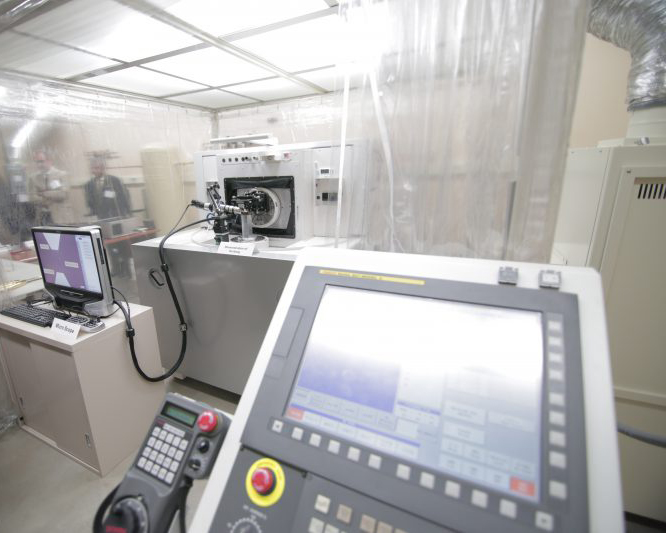
The University of Wisconsin-Madison College of Engineering is the new home of a unique machine that is capable of 3D milling precise to one nanometer. The machine, called the ROBONANO α-0iB, is the first of its kind in North America, and it brings extremely advanced technological capabilities that could represent the future of advanced manufacturing.
The ROBONANO, which is on a multi-year loan from the Japanese robotics manufacturer FANUC, arrived on Sept. 1, 2016, and is housed in the laboratory of Sangkee Min, an assistant professor of mechanical engineering at UW-Madison and a faculty member in the Grainger Institute for Engineering. Officials from FANUC traveled from Japan for a ribbon-cutting ceremony and open house for the ROBONANO, held Sept. 11, 2016. The ROBONANO’s extremely precise capabilities offer Min and colleagues exciting new research opportunities, which he hopes will open up improved and novel approaches to the manufacturing of everything from semiconductors to toys and mobile devices to scientific instruments.
The ROBONANO’s superiority over previous generations of similar machines is obvious: Its ability to cut at the nanoscale is two orders of magnitude more precise than most machines used in advanced manufacturing today.
The ROBONANO is a 5-axis machine that uses non-contact air bearings, which gives it nearly limitless configurations for cutting, scribing and milling materials. Where it’s truly exceptional, however, is in its nano precision. Many materials have different properties at the nanoscale, meaning the ROBONANO can potentially handle emerging and existing materials in new and useful ways.
Min will use the machine’s unique capabilities to explore its suitability for manufacturing emerging materials, as well as currently available materials like synthetic sapphire, which is a promising shatter-proof alternative to glass for screens on devices such as tablets and smartphones. Synthetic sapphire—which is made from heating aluminum oxide to extremely high temperatures—currently is difficult to manufacture at large scales because it is very brittle and difficult to handle. However, Min has already conducted initial research on synthetic sapphire with the ROBONANO machine in Japan and discovered that the material sometimes behaves ductile when handled at the extremely tiny nano level. “Many materials have different properties at the nanoscale that create all sorts of different possibilities that aren’t possible with conventional machines,” he says.
Related Glossary Terms
- aluminum oxide
aluminum oxide
Aluminum oxide, also known as corundum, is used in grinding wheels. The chemical formula is Al2O3. Aluminum oxide is the base for ceramics, which are used in cutting tools for high-speed machining with light chip removal. Aluminum oxide is widely used as coating material applied to carbide substrates by chemical vapor deposition. Coated carbide inserts with Al2O3 layers withstand high cutting speeds, as well as abrasive and crater wear.
- gang cutting ( milling)
gang cutting ( milling)
Machining with several cutters mounted on a single arbor, generally for simultaneous cutting.
- milling
milling
Machining operation in which metal or other material is removed by applying power to a rotating cutter. In vertical milling, the cutting tool is mounted vertically on the spindle. In horizontal milling, the cutting tool is mounted horizontally, either directly on the spindle or on an arbor. Horizontal milling is further broken down into conventional milling, where the cutter rotates opposite the direction of feed, or “up” into the workpiece; and climb milling, where the cutter rotates in the direction of feed, or “down” into the workpiece. Milling operations include plane or surface milling, endmilling, facemilling, angle milling, form milling and profiling.
- robotics
robotics
Discipline involving self-actuating and self-operating devices. Robots frequently imitate human capabilities, including the ability to manipulate physical objects while evaluating and reacting appropriately to various stimuli. See industrial robot; robot.






